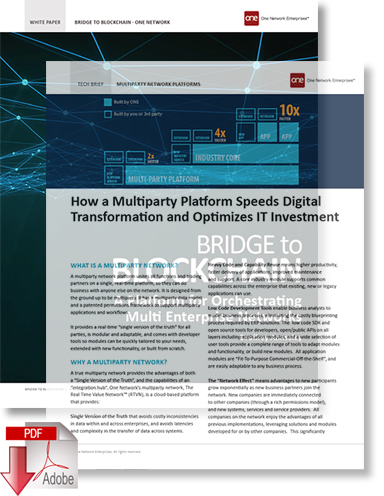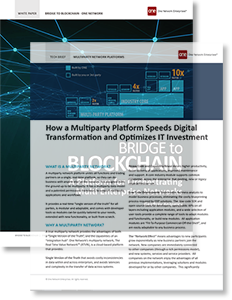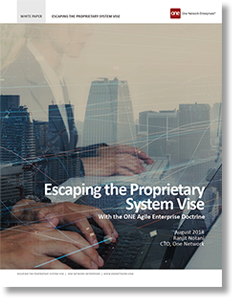Connecting Businesses
Multi-party network platforms offer a new way to connect businesses, with all companies (buyers, sellers, movers) synchronized to a single version of real-time data in the cloud.
This enables companies to achieve dramatic improvements in performance and efficiency that are simply not possible with traditional systems.
Companies on multi-party networks achieve some impressive results, including:
- Over 98% accuracy in demand forecast communicated from the retail location to the end tier supplier in real time.
- Over 99% service levels coupled with less than 7 days of inventory
- Ability to automate processes using AI and automatically fix disruptions as the happen (Automated Replenishment, Automated Forecast, Automated Allocation, etc.)
I am going to talk you through what you need to look for and must have in order to be successful.
With all the marketing around different solutions, there is a lot of confusion.
Connecting different systems together doesn’t create a true network, and often leads to complications and disaster.
Cliff Saran of Computer Weekly wrote;
“Businesses have less than a 50% chance of an SAP implementation delivering what it is supposed to, according to a new study.” Many companies have felt these pains. Datix documents a few of these, including “Avon’s $125 million SAP enterprise resource planning project failed after four years of work, development and employee testing.”
And the list goes on from Hewlett Packard to Hershey to Woolworth Australia.
Multiparty Network Questions & Answers
When looking under the hood of these technology platforms you are going to have to have some key components in order for you to achieve the results you are being promised.
Here is a list of questions you should ask about any proposed solution, and why they matter to your organization.
Is the solution modular making it easy for our organization to test and deploy?
Modularity is key to make sure platform-based solutions can be easily assembled from other smaller reusable modules. This keeps the system slimmer making it easier to test and deploy specific functionality of the module based on the customer’s needs, rather than dumping a large ERP system with lots of functionality on a customer.
This modularity allows One Network to fit to purpose the module based on the functions the customer needs today, along with the ability to quickly add new functionality with the flip of a switch as the customer’s needs grow tomorrow.
How do you keep my data secure on a network where multiple-parties are sharing the same data?
Anytime we are dealing with a multiparty network this comes with security concerns. Who can see my data and when? Who can act on my data and when? All these things have to be very carefully controlled. At One Network we take this very seriously.
One Network carefully controls what kind of business actions can be executed and by whom. This is strictly controlled by One Network’s permissibility, which gives you fine-grained control over who can see what type of data and when.
How are you able to work with massive amounts of data? Do I want to ensure that as my business quickly grows will this platform enable us to be agile?
A multi-party network platform contains massive amounts of data, a lot more than is typically stored by an enterprise system behind a firewall. This creates some concerns, namely:
- A large number of concurrent users
- Larger numbers of integration feeds and transaction processing
- Larger overall data size
The ONE platform is architected in such a way that it can horizontally scale with added capacity using techniques like virtualization. This means the technology can easily scale as the network grows, so there’s no degrading of system processing and user experience over time.
What makes your multi-party network platform reliable?
Data is crucial to any organization, without access to it the business would come to a standstill. To ensure the reliability of the data make sure the platform has been architected to ensure no single points of failure can ever occur. One Network system is designed so that the system can always function seamlessly regardless of the specific cause of the outage, whether a server crash, a disk failure or a database problem. The network remains functioning through all of these issues thanks to an active fault tolerance with at minimum active passive.
Is the multi-party platform interoperable with other systems?
This is a good question. Given the broad array of systems in place today, from the most modern using a service-oriented architecture with web services and rest APIs to back through asynchronous messaging using EDI, you need the ability to integrate these with your platform. One Network handles all types of these integrations. For example, large-scale ETL (extract, transform, load) type of integrations where there is a need to do large extracts of data for analytical purposes (e.g. POS data for retail). One Network’s platform also supports old legacy systems by dropping files over secure FTP. These types of integrations and large-scale formats are there are no agreed-upon cross-industry standards.
Does the platform enable flexibility for my business needs as they change into the future?
A platform needs to enable you to support any business processes needed through a rich Software Developer Kit (SDK) and user interface that supports highly flexible and configurable business processes. As part of its core modules, One Network provides you with a rich set of off-the-shelf functionality that spans the entire supply chain. This enables customers to add a layer over those modules to allow for small or large customizations (configurations), so they can tailor the solution to their processes and needs. These changes are maintained and supportable through upgrades and new releases.
There’s much more to this technology, so I recommend downloading the short report: Multiparty Platform Tech Brief (including the white paper Bridge to Blockchain: A Platform for Orchestrating Multi-Enterprise Networks).
About the Author
James Curtis is a Business Development Representative at One Network Enterprises. James enjoys helping companies get the most out of new technologies such as AI, IoT & Blockchain and real-time networks.
Related Resources
How a Multiparty Platform Speeds Digital Transformation and Optimizes IT Investment New!
If your business depends on complex relationships with hundreds or thousands of suppliers or trading partners; if it is multi-tier and global; then the Real Time Value Network is built for you. Download Now!
Escaping the Proprietary System Vise With ONE Agile Enterprise Doctrine New!
In this white paper, we suggest an approach to escaping the problem of ever-increasing legacy and proprietary systems and look at alternative approaches that have been considered and some of the problems with them. Download Now!
More Resources from One Network Enterprises
Article topics
Email Sign Up




















